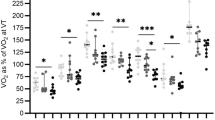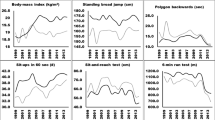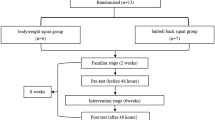Abstract
OBJECTIVE: To study the effect of physical activity on whole body fat (BF), its regional deposition and the influence of body fatness on physical performance in prepubertal children.
DESSIGN: Cross-sectional study.
SUBJECTS: A total of 114 boys (9.4±1.5?y, Tanner I–II), randomly sampled from the population of Gran Canaria (Spain), 63 of them physically active (PA, at least 3?h per week during the previous year) and 51 nonphysically active (non-PA).
MEASUREMENTS: Body composition (DXA), anthropometric variables (body circumferences and skinfolds) and physical fitness were determined in all subjects.
RESULTS: The PA obtained better results in maximal oxygen uptake, isometric leg extension force, vertical jump (muscular power), and 300?m (anaerobic capacity) and 30?m running tests (speed) than the non-PA. A lower percentage of body fat (% BF) (4?U less, P<0.05), whole BF mass (36% less, P<0.05) and regional fat mass (28, 25, and 30% less in the trunk, legs and arms, respectively, all P<0.05) was observed in the PA compared to the non-PA. The waist and hip circumferences correlated more closely with both the fat mass accumulated in the trunk region and the % BF (r=0.81–0.95, P<0.001) than the waist-to-hip ratio (WHR). The WHR correlated with the percentage of the whole fat mass accumulated in the trunk (PFT) (r=0.52–0.53, P<0.001). In both groups, the PFT increased curvilinearly with the % BF, regardless of the level of physical activity. ANCOVA analysis revealed that total and regional fat masses explained less than 40% of the difference in performance between the PA and non-PA group. The mean speed in the 30?m running test (V30), combined with the height and whole body mass, has predictive value for the BF mass (R=0.98, P<0.001). The % BF may be estimated from the body mass index (BMI) and V30 (% BF=8.09+2.44·BMI (kg?m−2)–5.8·V30 (m?s−1), R=0.94, P<0.001) in prepubertal boys.
CONCLUSIONS: Regular participation in at least 3?h per week of sports activities and competitions on top of the compulsory physical education program is associated with increased physical fitness, lower whole body and trunkal fat mass in prepubertal boys.
This is a preview of subscription content, access via your institution
Access options
Subscribe to this journal
Receive 12 print issues and online access
$259.00 per year
only $21.58 per issue
Buy this article
- Purchase on Springer Link
- Instant access to full article PDF
Prices may be subject to local taxes which are calculated during checkout


Similar content being viewed by others
References
Reilly JJ, Dorosty AR . Epidemic of obesity in UK children. Lancet 1999; 354: 1874–1875.
Spurgeon D . Childhood obesity in Canada has tripled in past 20 years. BMJ 2002; 324: 1416.
Ogden CL, Flegal KM, Carroll MD, Johnson CL . Prevalence and trends in overweight among US children and adolescents, 1999–2000. JAMA 2002; 288: 1728–1732.
Jolliffe D . Extent of overweight among US children and adolescents from 1971 to 2000. Int J Obes Relat Metab Disord 2004; 28: 4–9.
Birch LL, Fisher JO . Development of eating behaviors among children and adolescents. Pediatrics 1998; 101: 539–549.
Gillis LJ, Kennedy LC, Gillis AM, Bar-Or O . Relationship between juvenile obesity, dietary energy and fat intake and physical activity. Int J Obes Relat Metab Disord 2002; 26: 458–463.
Ludwig DS, Peterson KE, Gortmaker SL . Relation between consumption of sugar-sweetened drinks and childhood obesity: a prospective, observational analysis. Lancet 2001; 357: 505–508.
Ebbeling CB, Pawlak DB, Ludwig DS . Childhood obesity: public-health crisis, common sense cure. Lancet 2002; 360: 473–482.
Maffeis C, Tato L . Long-term effects of childhood obesity on morbidity and mortality. Horm Res 2001; 55: 42–45.
Dietz WH . Health consequences of obesity in youth: childhood predictors of adult disease. Pediatrics 1998; 101: 518–525.
Power C, Lake JK, Cole TJ . Measurement and long-term health risks of child and adolescent fatness. Int J Obes Relat Metab Disord 1997; 21: 507–526.
DuRant RH, Baranowski T, Johnson M, Thompson WO . The relationship among television watching, physical activity, and body composition of young children. Pediatrics 1994; 94: 449–455.
Maffeis C, Zaffanello M, Schutz Y . Relationship between physical inactivity and adiposity in prepubertal boys. J Pediatr 1997; 131: 288–292.
Davies PS, Gregory J, White A . Physical activity and body fatness in pre-school children. Int J Obes Relat Metab Disord 1995; 19: 6–10.
Moreno LA, Fleta J, Mur L . Television watching and fatness in children. JAMA 1998; 280: 1230–1231.
Stafford M, Wells JC, Fewtrell M . Television watching and fatness in children. JAMA 1998; 280: 1231–1232.
Vioque J, Torres A, Quiles J . Time spent watching television, sleep duration and obesity in adults living in Valencia, Spain. Int J Obes Relat Metab Disord 2000; 24: 1683–1688.
AAP. American Academy of Pediatrics: children, adolescents, and television. Pediatrics 2001; 107: 423–426.
Goran MI, Shewchuk R, Gower BA, Nagy TR, Carpenter WH, Johnson RK . Longitudinal changes in fatness in white children: no effect of childhood energy expenditure. Am J Clin Nutr 1998; 67: 309–316.
Johnson MS, Figueroa-Colon R, Herd SL, Fields DA, Sun M, Hunter GR, Goran MI . Aerobic fitness, not energy expenditure, influences subsequent increase in adiposity in black and white children. Pediatrics 2000; 106: E50.
Eisenmann JC, Bartee RT, Wang MQ . Physical activity, TV viewing, and weight in U.S. youth: 1999 Youth Risk Behavior Survey. Obes Res 2002; 10: 379–385.
Harrell JS, McMurray RG, Gansky SA, Bangdiwala SI, Bradley CB . A public health vs a risk-based intervention to improve cardiovascular health in elementary school children: the Cardiovascular Health in Children Study. Am J Public Health 1999; 89: 1529–1535.
Berkey CS, Rockett HR, Gillman MW, Colditz GA . One-year changes in activity and in inactivity among 10- to 15-year-old boys and girls: relationship to change in body mass index. Pediatrics 2003; 111: 836–843.
Gutin B, Barbeau P, Owens S, Lemmon CR, Bauman M, Allison J, Kang HS, Litaker MS . Effects of exercise intensity on cardiovascular fitness, total body composition, and visceral adiposity of obese adolescents. Am J Clin Nutr 2002; 75: 818–826.
Vicente-Rodriguez G, Jimenez-Ramirez J, Ara I, Serrano-Sanchez JA, Dorado C, Calbet JA . Enhanced bone mass and physical fitness in prepubescent footballers. Bone 2003; 33: 853–859.
Gutin B, Basch C, Shea S, Contento I, DeLozier M, Rips J, Irigoyen M, Zybert P . Blood pressure, fitness, and fatness in 5- and 6-year-old children. JAMA 1990; 264: 1123–1127.
Kissebah AH, Krakower GR . Regional adiposity and morbidity. Physiol Rev 1994; 74: 761–811.
Hunter GR, Kekes-Szabo T, Snyder SW, Nicholson C, Nyikos I, Berland L . Fat distribution, physical activity, and cardiovascular risk factors. Med Sci Sports Exerc 1997; 29: 362–369.
Cole TJ, Bellizzi MC, Flegal KM, Dietz WH . Establishing a standard definition for child overweight and obesity worldwide: international survey. BMJ 2000; 320: 1240–1243.
Lopez Calbet JA, Armengol O, Chavarren J, Dorado C . Anthropometric equation for assessment of percent body fat in adult males of the Canary Islands. Med Clin (Barc) 1997; 108: 207–213.
Calbet JA, Moysi JS, Dorado C, Rodriguez LP . Bone mineral content and density in professional tennis players. Calcif Tissue Int 1998; 62: 491–496.
Bosco C, Luhtanen P, Komi PV . A simple method for measurement of mechanical power in jumping. Eur J Appl Physiol Occup Physiol 1983; 50: 273–282.
Medbo JI, Mohn AC, Tabata I, Bahr R, Vaage O, Sejersted OM . Anaerobic capacity determined by maximal accumulated O2 deficit. J Appl Physiol 1988; 64: 50–60.
Calbet JA, De Paz JA, Garatachea N, Cabeza de Vaca S, Chavarren J . Anaerobic energy provision does not limit Wingate exercise performance in endurance-trained cyclists. J Appl Physiol 2003; 94: 668–676.
Dorado C, Sanchis-Moysi J, Calbet JAL . Effects of recovery mode on performance, O2 uptake, and O2 deficit during high-intensity intermittent exercise. Can J Appl Physiol 2004; 29: 227–244.
Leger LA, Mercier D, Gadoury C, Lambert J . The multistage 20 metre shuttle run test for aerobic fitness. J Sports Sci 1988; 6: 93–101.
Ballor DL, Keesey RE . A meta-analysis of the factors affecting exercise-induced changes in body mass, fat mass and fat-free mass in males and females. Int J Obes Relat Metab Disord 1991; 15: 717–726.
Goran MI . Visceral fat in prepubertal children: influence of obesity, anthropometry, ethnicity, gender, diet, and growth. Am J Human Biol 1999; 11: 201–207.
Goran MI, Kaskoun M, Shuman WP . Intra-abdominal adipose tissue in young children. Int J Obes Relat Metab Disord 1995; 19: 279–283.
Lemieux S, Prud'homme D, Bouchard C, Tremblay A, Despres JP . Sex differences in the relation of visceral adipose tissue accumulation to total body fatness. Am J Clin Nutr 1993; 58: 463–467.
Gutin B, Owens S . Role of exercise intervention in improving body fat distribution and risk profile in children. Am J Human Biol 1999; 11: 237–247.
Goran MI, Gower BA . Relation between visceral fat and disease risk in children and adolescents. Am J Clin Nutr 1999; 70: 149S–156S.
Ross R, Leger L, Morris D, de Guise J, Guardo R . Quantification of adipose tissue by MRI: relationship with anthropometric variables. J Appl Physiol 1992; 72: 787–795.
Taylor RW, Jones IE, Williams SM, Goulding A . Evaluation of waist circumference, waist-to-hip ratio, and the conicity index as screening tools for high trunk fat mass, as measured by dual-energy X-ray absorptiometry, in children aged 3–19 y. Am J Clin Nutr 2000; 72: 490–495.
World Health Organization. Obesity: preventing and managing the global endemic. WHO Technical Report Series No. 894 WHO, Geneva; 2000.
James WP, Ralph A . New understanding in obesity research. Proc Nutr Soc 1999; 58: 385–393.
Wells JC, Coward WA, Cole TJ, Davies PS . The contribution of fat and fat-free tissue to body mass index in contemporary children and the reference child. Int J Obes Relat Metab Disord 2002; 26: 1323–1328.
Svendsen OL, Haarbo J, Hassager C, Christiansen C . Accuracy of measurements of body composition by dual-energy X-ray absorptiometry in vivo. Am J Clin Nutr 1993; 57: 605–608.
Gutin B, Litaker M, Islam S, Manos T, Smith C, Treiber F . Body-composition measurement in 9–11-y-old children by dual-energy X-ray absorptiometry, skinfold-thickness measurements, and bioimpedance analysis. Am J Clin Nutr 1996; 63: 287–292.
Dwyer T, Blizzard CL . Defining obesity in children by biological endpoint rather than population distribution. Int J Obes Relat Metab Disord 1996; 20: 472–480.
Taylor RW, Falorni A, Jones IE, Goulding A . Identifying adolescents with high percentage body fat: a comparison of BMI cutoffs using age and stage of pubertal development compared with BMI cutoffs using age alone. Eur J Clin Nutr 2003; 57: 764–769.
Gonzalez-Gross M, Ruiz JR, Moreno LA, De Rufino-Rivas P, Garaulet M, Mesana MI, Gutierrez A . Body composition and physical performance of Spanish adolescents: the AVENA pilot study. Acta Diabetol 2003; 40 (Suppl 1): S299–301.
Dore E, Diallo O, Franca NM, Bedu M, Van Praagh E . Dimensional changes cannot account for all differences in short-term cycling power during growth. Int J Sports Med 2000; 21: 360–365.
Mercier B, Mercier J, Granier P, Le Gallais D, Prefaut C . Maximal anaerobic power: relationship to anthropometric characteristics during growth. Int J Sports Med 1992; 13: 21–26.
Moreno LA, Fleta J, Sarria A, Rodriguez G, Gil C, Bueno M . Secular changes in body fat patterning in children and adolescents of Zaragoza (Spain), 1980–1995. Int J Obes Relat Metab Disord 2001; 25: 1656–1660.
Acknowledgements
We owe special thanks to José Navarro de Tuero and Jorge Cortadellas Izquierdo for their excellent technical assistance. This study was supported by grants from the Ministerio de Educación, Cultura y Deportes (AP2000-3652), Universidad de Las Palmas de Gran Canaria (PhD grant to Ignacio Ara), Gobierno de Canarias (PI2000/067), and Consejo Superior de Deportes (27/UNI10/00).
Author information
Authors and Affiliations
Corresponding author
Rights and permissions
About this article
Cite this article
Ara, I., Vicente-Rodríguez, G., Jimenez-Ramirez, J. et al. Regular participation in sports is associated with enhanced physical fitness and lower fat mass in prepubertal boys. Int J Obes 28, 1585–1593 (2004). https://doi.org/10.1038/sj.ijo.0802754
Received:
Revised:
Accepted:
Published:
Issue Date:
DOI: https://doi.org/10.1038/sj.ijo.0802754
Keywords
This article is cited by
-
Assessment of the perception of physical competence in Brazilian adolescents of different nutritional status
Sport Sciences for Health (2019)
-
Body composition and lipid profile of regular recreational table tennis participants: a cross-sectional study of older adult men
Sport Sciences for Health (2018)
-
A 5-year exercise program in children improves muscle strength without affecting fracture risk
European Journal of Applied Physiology (2016)
-
A 3-year school-based exercise intervention improves muscle strength - a prospective controlled population-based study in 223 children
BMC Musculoskeletal Disorders (2014)
-
Fitness level and body composition indices: cross-sectional study among Malaysian adolescent
BMC Public Health (2014)



